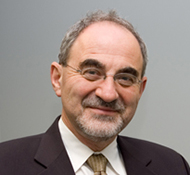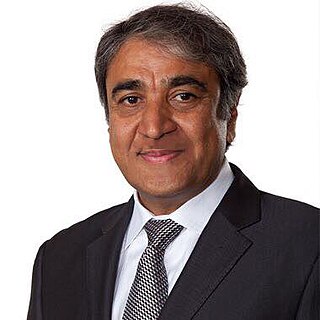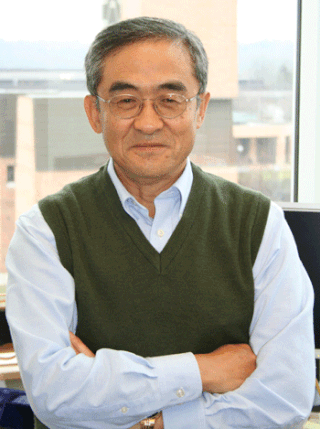
Eli Yablonovitch is an American physicist and engineer who, along with Sajeev John, founded the field of photonic crystals in 1987. He and his team were the first to create a 3-dimensional structure that exhibited a full photonic bandgap, which has been named Yablonovite. In addition to pioneering photonic crystals, he was the first to recognize that a strained quantum-well laser has a significantly reduced threshold current compared to its unstrained counterpart. This is now employed in the majority of semiconductor lasers fabricated throughout the world. His seminal paper reporting inhibited spontaneous emission in photonic crystals is among the most highly cited papers in physics and engineering.

Embedded software is computer software, written to control machines or devices that are not typically thought of as computers, commonly known as embedded systems. It is typically specialized for the particular hardware that it runs on and has time and memory constraints. This term is sometimes used interchangeably with firmware.
The Ptolemy Project is an ongoing project aimed at modeling, simulating, and designing concurrent, real-time, embedded systems. The focus of the Ptolemy Project is on assembling concurrent components. The principal product of the project is the Ptolemy II model based design and simulation tool. The Ptolemy Project is conducted in the Industrial Cyber-Physical Systems Center (iCyPhy) in the Department of Electrical Engineering and Computer Sciences of the University of California at Berkeley, and is directed by Prof. Edward A. Lee.
Randy Howard Katz is a distinguished professor emeritus at University of California, Berkeley of the electrical engineering and computer science department.
David G. Messerschmitt is an engineer and professor emeritus at the University of California, Berkeley in the Department of Electrical Engineering and Computer Sciences in the UC Berkeley College of Engineering. He retired from UC Berkeley in 2005. At present he is conducting research at Berkeley, is a visiting professor in the Software Business Laboratory at the Helsinki University of Technology, and is doing research on interstellar communications at the SETI Institute. Messerschmitt also serves on the Advisory Council of METI.

S. Shankar Sastry is the Founding Chancellor of the Plaksha University, Mohali and a former Dean of Engineering at University of California, Berkeley.
A cyber-physicalsystem (CPS) or intelligent system is a computer system in which a mechanism is controlled or monitored by computer-based algorithms. In cyber-physical systems, physical and software components are deeply intertwined, able to operate on different spatial and temporal scales, exhibit multiple and distinct behavioral modalities, and interact with each other in ways that change with context. CPS involves transdisciplinary approaches, merging theory of cybernetics, mechatronics, design and process science. The process control is often referred to as embedded systems. In embedded systems, the emphasis tends to be more on the computational elements, and less on an intense link between the computational and physical elements. CPS is also similar to the Internet of Things (IoT), sharing the same basic architecture; nevertheless, CPS presents a higher combination and coordination between physical and computational elements.
David Ethan Culler is a computer scientist and former chair of the Department of Electrical Engineering and Computer Sciences at the University of California, Berkeley. He is a principal investigator in the Software Defined Buildings (SDB) project at the EECS Department at Berkeley and the faculty director of the i4Energy Center. His research addresses networks of small, embedded wireless devices, planetary-scale internet services, parallel computer architecture, parallel programming languages, and high performance communication. This includes TinyOS, Berkeley Motes, PlanetLab, Networks of Workstations (NOW), Internet services, Active Message, Split-C, and the Threaded Abstract Machine (TAM).

John F. Canny is an Australian computer scientist, and Paul E Jacobs and Stacy Jacobs Distinguished Professor of Engineering in the Computer Science Department of the University of California, Berkeley. He has made significant contributions in various areas of computer science and mathematics, including artificial intelligence, robotics, computer graphics, human-computer interaction, computer security, computational algebra, and computational geometry.

Pradeep Kumar Khosla is an Indian-American computer scientist and university administrator. He is the current chancellor of the University of California, San Diego.

Kang Geun Shin is a South Korean-born computer scientist and the Kevin and Nancy O'Connor Professor of Computer Science in the Electrical Engineering and Computer Science Department at the University of Michigan. He is also the founding director of the Real-Time Computing Laboratory (RTCL). He is known for his contributions to the field of real-time fault-tolerant systems. Shin is a recipient of the Korean Ho-Am Prize in Engineering. This prize is awarded for the "outstanding contributions to the development of science and culture and enhancement of the welfare of mankind".

Jitendra Malik is an Indian-American academic who is the Arthur J. Chick Professor of Electrical Engineering and Computer Sciences at the University of California, Berkeley. He is known for his research in computer vision.
Synchronous Data Flow (SDF) is a restriction on Kahn process networks where the number of tokens read and written by each process is known ahead of time. In some cases, processes can be scheduled such that channels have bounded FIFOs.
Pravin Pratap Varaiya was Nortel Networks Distinguished Professor in the Department of Electrical Engineering at the University of California, Berkeley.
Rajesh K. Gupta is a computer scientist and engineer, currently the Qualcomm Professor in Embedded Microsystems at University of California, San Diego. His research concerns design and optimization of cyber-physical systems (CPS). He is a Principal Investigator in the NSF MetroInsight project and serves as Associate Director of the Qualcomm Institute. His research contributions include SystemC and SPARK Parallelizing High-level Synthesis. Earlier he led NSF Expeditions on Variability in Microelectronic circuits.
Karl Henrik Johansson is a Swedish researcher and best known for his pioneering contributions to networked control systems, cyber-physical systems, and hybrid systems. His research has had particular application impact in transportation, automation, and energy networks. He holds a Chaired Professorship in Networked Control at the KTH Royal Institute of Technology in Stockholm, Sweden. He is Director of KTH Digital Futures.
Eugene Wong is a Chinese-American computer scientist and mathematician. Wong's career has spanned academia, university administration, government and the private sector. Together with Michael Stonebraker and a group of scientists at IBM, Wong is credited with pioneering database research in the 1970s from which software developed by IBM, Microsoft, and Oracle descends. Wong retired in 1994, since then holding the title of Professor Emeritus of Electrical Engineering and Computer Sciences at University of California, Berkeley.

Costas J. Spanos is the Director of the Center for Information Technology Research in the Interest of Society (CITRIS) at UC Berkeley. He is also the CEO of the Berkeley Educational Alliance for Research in Singapore (BEARS) and the Andrew S. Grove Distinguished Professor of Electrical Engineering and Computer Sciences (EECS) at UC Berkeley.
Insup Lee is the Cecilia Fitler Moore Professor in the Department of Computer and Information Science at the University of Pennsylvania, United States. He is also the Director and co-founder of the PRECISE Center.

Chelsea Finn is an American computer scientist and assistant professor at Stanford University. Her research investigates intelligence through the interactions of robots, with the hope to create robotic systems that can learn how to learn. She is part of the Google Brain group.









